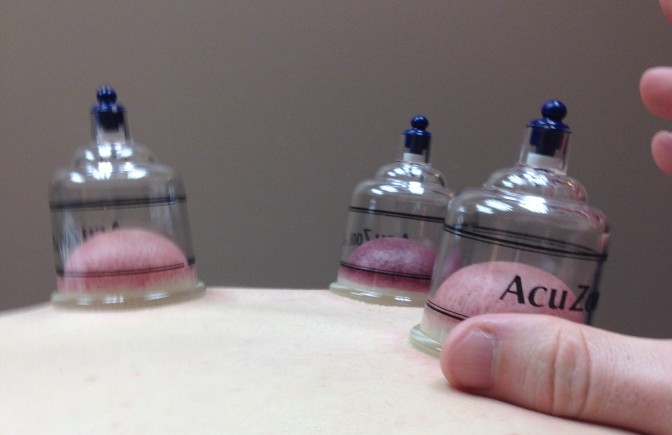What is Therapeutic Cupping?
Cup suction serves as a “Reverse Deep Tissue Massage.” Multiple cups are placed on the skin and vacuum suction is applied. 5 minutes of cupping is the equivalent to a 20-30 minute Deep Tissue Massage in that area. Therapeutic Cupping is used for pain relief and restriction.
 Benefits of Therapeutic Cupping include:
Benefits of Therapeutic Cupping include:
Pain Relief
Loosens Muscles
Deep Myofascial Release
Break up Scar Tissue
Trigger Point Therapy
Boosts Lymphatic System
Boosts Immune System
Improves Circulation
Improves Range of Motion
Improves Flexibility
Clears and Shrinks Pores
Boosts Collagen
Improves Nerve Function
Cellulite Reduction

What to expect with Therapeutic Cupping:
Cupping can be somewhat tender, but the long-term benefits provided with the treatment strongly outweigh the short-term discomfort. Usually when the cups are initially applied, it is more sensitive for 30 seconds to 3 minutes depending on the problem area. You can tell that the Cupping treatment is working when the cups become less sensitive. When things become less sensitive, your pain is essentially being worked out and this means that the treatment is working.

What the heck are those red circle marks?
The red marks are the bruises left behind from the suction. Blood vessels are burst beneath the skin. This promotes healing to that area.
The marks tell a story. The darker the marks, the more problematic that area is. This means that area is really tight or restricted, lacking circulation, or damaged. The more that you have cupping done, the less intense the marks will look. Eventually, the marks may go from a solid dark maroon to more of a marbling, and then eventually not change much color at all. When the marks are less intense, this is visual proof that the cupping treatments are working. Some people get darker marks than others and sometimes this has to do with how strong their immune system is. If you have a stronger immune system, often the marks will not be as intense looking or last as long. Some of the marks may be sensitive to the touch shortly after the treatment. This usually is only if you poke at that spot.

Sliding Cupping is a variation of Therapeutic Cupping where a cup is applied to the skin and then slid up and down, and side to side. The cup suction still holds when the cup is being slid. This allows for a deeper myofascial release. Sliding cupping is more sensitive and sometimes even painful. It is extra beneficial for breaking up scar tissue, adhesions, and restriction. Sliding cupping will break up the blood vessels under the skin (petechiae) leaving red irritated marks. These marks will not be as dark as the perfect circle marks seen in therapeutic cupping, and they will heal faster. Sliding Cupping is an even quicker fix than regular Therapeutic Cupping.

Active cupping is yet another variation of therapeutic cupping. The cups are kept in place and the client is asked to do certain movements that activate the muscles that are being cupped. The muscles are being shortened by the cups and the moves stretch the muscles back out, but the cups are telling them right where to stretch. This type of cupping, like sliding cupping, is usually more sensitive than regular therapeutic cupping.
Each type of cupping has its own use or purpose. I like to get people used to regular cupping before trying sliding or active cupping. Regular cupping breaks up restriction. Sliding cupping gets deeper and is more sensitive, and active cupping can feel deeper and even more sensitive.
The cupping process causes short-term inflammation to whatever area was cupped. You will have raised, inflamed circles, with a perfect circle indent around the edge of that circle. This can temporarily cause that area to itch when you put your clothes back on because of the two different surfaces to the skin. The inflammation usually lasts 1-2 hours after treatment.

Besides all of the benefits listed above, cupping stimulates the body to heal itself.
It is recommended to have a higher water intake for a couple of days following a cupping treatment. The extra water will help flush out “toxins” and also help to rehydrate the treated areas.
At Structure Therapy, I use therapeutic cupping to complement a Deep Tissue Structure Therapy treatment or Instrument Assisted Soft Tissue Mobilization treatment.
I often use cupping in areas where I cannot apply as much pressure through massage, like near the spine for example. There is only so much pressure that I can give near the spine before it is too much. When I cup near the spine, the reverse vacuum pressure often allows me to get a deeper release in the muscles near the spine that I could get with massage. The result is often that the back muscles will be looser than they have been in a long time.

At Structure Therapy, a typical cupping session lasts 30 minutes and usually treats two areas.
If you come in for an hour, you can have the first 30 minutes be massage, and the last 30 minutes cupping.

For longer appointments (90-120 minutes), I offer massage and cupping at the same time. This means that I can be cupping one area of the body at the same time that I am massaging a different area of the body. This is my favorite type of treatment because it is the most effective. You are able to get a lot more work done in one session because it is essentially double the treatment. For those that have a lot of pain in multiple areas, this is your best option for treatment because it will give you more relief in more areas faster.
Types of Cupping offered at Structure Therapy include:
Therapeutic Cupping (Regular, Sliding or also called gliding, and Active)
Facial Rejuvenation Cupping
Cellulite Reduction Cupping
Abdominal Cupping
Want to feel better? Get spotted!


3 thoughts on “Why Would Anyone Try Therapeutic Cupping?”